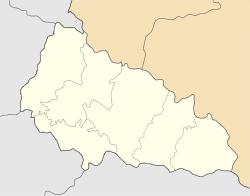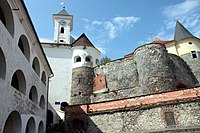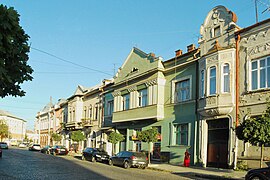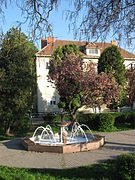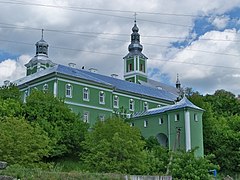Mukachevo
This articleneeds additional citations forverification.(January 2023) |
Mukachevo
Мукачево Munkács | |
|---|---|
| |
| Coordinates:48°27′00″N22°45′00″E/ 48.45000°N 22.75000°E | |
| Country | |
| Oblast | Zakarpattia Oblast |
| Raion | Mukachevo Raion |
| Hromada | Mukachevo urban hromada |
| Founded | 896 |
| Government | |
| •Mayor | Andriy Baloha[1][2] |
| Area | |
| • Land | 27.9 km2(10.8 sq mi) |
| Elevation | 125 m (410 ft) |
| Population (2022) | |
• Total | 85,569 |
| • Density | 3,187/km2(8,250/sq mi) |
| Time zone | UTC+2(EET) |
| • Summer (DST) | UTC+3(EEST) |
| Postal code | 89600 |
| Area code | +380 3131 |
| Climate | Cfb |
| Website | Mukachevo City Council |
Mukachevo(Ukrainian:Мукачево,IPA:[mʊˈkɑtʃewo];Hungarian:Munkács,IPA:[ˈmuŋkaːtʃ];see name section) is a city inZakarpattia Oblast,westernUkraine.It is situated in the valley of theLatorica Riverand serves as theadministrative centerofMukachevo Raion.The city is a rail terminus and highway junction, and has beer, wine, tobacco, food, textile, timber, and furniture industries. During theCold War,it was home toMukachevo air baseand aradar station.
Mukachevo lies close to the borders of four neighbouring countries: Poland, Slovakia, Hungary, and Romania. Today, the population is85,569 (2022 estimate).[3]The city is a traditional stronghold of theRusyn language,and the population of Mukachevo is officially reported as 77.1% ethnicUkrainian.[4]There are also significant minorities of:Russians(9.0%);Hungarians(8.5%);Germans(1.9%); andRoma(1.4%).[4]
While Uzhhorod is the main administrative city in the region, Mukachevo is a historic spiritual center of the region and center of the former Eastern Orthodox eparchy of Kyivan Metropolis. In 17th century it united with Catholic church by theUnion of Uzhhorod,similar to theUnion of Brest.Up until World War II and theHolocaust,Mukachevo was primarily a Jewish town, and half the population was Jewish (see below), the rest of the population being Russians, Hungarians, Slovaks, and other minorities. Formerly in Czechoslovakia, and before that in Hungary, it was incorporated intoSoviet Ukraineafter World War II.
Name
[edit]Most probably, the name derives from the Hungarian surname "Muncas" —munkás (worker)—which later transformed into Munkács.[5]Another version points that the name contains the proto-Slavic root word "Muka" meaning "flour".[5]
On 23 May 2017, theUkrainian parliamentofficially renamed Mukacheve (Мукачеве) into Mukachevo (Мукачево), a year after the city council had decided to rename the city.[6]Previously, it was usually spelled in Standard Literary Ukrainian as Mukacheve while Мукачів (Mukachiv) was sometimes also used.[7]The city's name inRussianisМукачево(Mukachevo), as well as a name adopted by the local authorities and portrayed on the city's coat of arms. The name of the city in other languages includeHungarian:Munkács;Rusyn:Мукачово(Mukachovo),Belarusian:Мукачава(Mukačava),Romanian:Muncaci, Munceag;PolishMukaczewo;SlovakandCzech:Mukačevo;German:Munkatsch;Yiddish:מונקאַטש(Munkatsh', local pronunciation 'Minkatsh').
History
[edit]Early history
[edit]Archaeological excavation suggest that early settlements existed here before theMiddle Ages.For example, a Celticoppidumand metal works center that existed in the 3rd-1st century BC were found between the Halish and Lovachka mountains. AThracianfortof theIron Age(10th century BC) was found on the mountain of Tupcha. Around the 1st century the area was occupied by theCarpipeople who displaced the localCeltsfrom the area. TheSlavssettled the territory in the 6th century.
Hungarian rule
[edit]In 895 theHungarian tribes entered the Carpathian Basinthrough theVeretskyi Pass,about 60 km (37 mi) north of present-day Mukachevo. In 1397, the town and its surrounding was granted bySigismund, Holy Roman Emperor,to his distant cousin, the exiled prince of Grand Duchy of LithuaniaFyodor Koriatovych,who used to administer the Ruthenian Podolia region of the Grand Duchy of Lithuania, until was exiled for disobedience by Grand Duke Vytautas the Great in 1392. Theodor therefore became a vassal of Hungary and settled manyRutheniansin the territory. Other sources, however, state that Theodor bought the town and the surrounding area in 1396. During the 15th century, the city prospered and became a prominent craft and trade center for the region. In 1445, the town became a Hungarianroyal free city.It was also grantedMagdeburg rights.
During the 16th century, Munkács became part of thePrincipality of Transylvania.The 17th century (from 1604 to 1711) was a time of continuous struggle against the expansionist intentions of theHabsburg Empirefor the Principality. In 1678 the anti-Habsburg Revolt ofEmeric Thökölystarted out from Munkács. The region also played an important role inRákóczi's War of Independence.

Austrian control and revolts
[edit]After the defeat ofFrancis II Rákóczithe city came under Austrian control in the mid-18th century as part of the Kingdom of Hungary and was made a key fortress of theHabsburg monarchy.In 1726, thePalanok Castleand the town, before 1711 owned by theRákóczifamily, was given by the Habsburgs to theSchönborn family,who were responsible for an expansion of the town. They also settled manyGermansin the territory, thereby causing an economic boom of the region. During 1796–1897, the city's castle, until then a strong fortress, became a prison. TheGreeknational heroAlexander Ypsilantiwas imprisoned at the Palanok Castle between 1821 and 1823.
Mukachevo during and after the wars
[edit]
In 1919, after theRusyn Americansagreed withTomáš Masarykon the incorporation ofCarpathian RutheniaintoCzechoslovakia,the whole ofCarpathian Rutheniawas occupied by Czechoslovak troops. On 4 June 1920, Mukachevo officially became part of Czechoslovakia through theTreaty of Trianon.In November 1938, a part of the territory of the former Kingdom of Hungary was re-annexed by Hungary as part of theFirst Vienna Award.
Without delay the new authorities decreed the expulsion of all Jews without Hungarian citizenship. As a consequence, Polish and Russian Jews, long-term residents of the now Hungarian-controlled Transcarpathian region, and also from Mukachevo, as well as the native Jews who could not prove their citizenship, were deported over the Ukrainian border where they were turned over to theGermanEinsatzgruppecommando led byFriedrich Jeckeln.On 27 and 28 August 1941, they were all murdered by the Germans inKamianets-Podilskyi'smassacre.[8]Even so, Mukachevo's population still held an important Jewish component, up until 1944 when all remaining Jews were deported to theAuschwitz concentration campbyAdolf Eichmann.
At the end of 1944, theRed Armystormed Carpathian Ruthenia. At first the territory was given to the re-established Czechoslovakia, which then became part of theSoviet Unionlater in 1945 by a treaty between the two countries. The Soviet Union began a policy of expulsion of the Hungarian population. In 1945, the city was ceded to theUkrainian Soviet Socialist Republic,and is currently under the sovereignty ofUkraine.Since 2002, Mukachevo has been the seat of theRoman Catholic Diocese of Mukachevo.The128th Mountain Assault Brigadeof theUkrainian Ground Forceshas been based in Mukachevo sinceWorld War II.
Geography
[edit]Climate
[edit]Mukachevo has ahumid continental climate(Köppen:Dfb).
| Climate data for Mukachevo | |||||||||||||
|---|---|---|---|---|---|---|---|---|---|---|---|---|---|
| Month | Jan | Feb | Mar | Apr | May | Jun | Jul | Aug | Sep | Oct | Nov | Dec | Year |
| Daily mean °C (°F) | −2.7 (27.1) |
−0.5 (31.1) |
4.5 (40.1) |
10.5 (50.9) |
15.3 (59.5) |
18.2 (64.8) |
20.0 (68.0) |
19.4 (66.9) |
15.5 (59.9) |
10.2 (50.4) |
4.7 (40.5) |
0.1 (32.2) |
9.6 (49.3) |
| Averageprecipitationmm (inches) | 46 (1.8) |
39 (1.5) |
40 (1.6) |
47 (1.9) |
70 (2.8) |
87 (3.4) |
78 (3.1) |
70 (2.8) |
50 (2.0) |
46 (1.8) |
51 (2.0) |
59 (2.3) |
683 (27) |
| Source: Climate-Data.org[9] | |||||||||||||
Demographics
[edit]In 1910, the Hungarian Statistical Report recorded 17,275 inhabitants in Mukachevo. Of those, 12,686 persons, (73,44%) declared themselves Hungarian, 3078 (17,82%), German, and 1394 (8,07%) Rusyn. In terms of religious affiliations, 7675 persons (44,43%) were Israelites/Jewish, 4081 persons (23,62%) were Greek-Catholic, 3526 persons (20,41%) were Roman-Catholic, 1771 persons (10,25%) were Reformed Protestants /Calvinists and 190 persons (1,1%) were Evangelical Protestants/Lutherans.[10]
In 1921, 21,000 people lived in Mukachevo. Of these, 48% were Jewish, 24% were Rusyn, and 22% were Hungarian.[7]
In 1966, 50,500 people lived in Mukachevo. Of these, 60% were Ukrainian, 18% were Hungarian, 10% were Russian, and 6% were Jewish.[7]
According to the 2001 census, 82,200 people live in Mukachevo. The population in 1989 was 91,000, in 2004, 77,300 and in 2008, 93,738. Its population includes:[11]
Residents in seven villages of theMukachevo Raionhave the option to learn the Hungarian language in a school or home school environment.[12]
Economy
[edit]
Fischer Sports,anAustriancompany that producesNordic skiing,Alpine skiing,andice hockeyequipment, has a factory in Mukachevo. The firm benefits from provisional application on January 1, 2016 of theDeep and Comprehensive Free Trade Areaprovisions of theEuropean Union–Ukraine Association Agreement.[13]
Jewish community
[edit]- See alsoMunkacs (Hasidic dynasty)
There are documents in theBerehove(Beregszász) State Archives which indicate that Ashkenazi Jews lived in Munkács and the surrounding villages as early as the second half of the seventeenth century. The Jewish community of Munkács was an amalgam ofGalicianand HungarianHasidic Jewry,Orthodox Jews, and Zionists. The town is most noted for its Chief RabbiChaim Elazar Spirawho led the community until his death in 1937.
By 1851, Munkács supported a largeyeshiva,thereby demonstrating the community's commitment toTalmudiclearning and piety.
Materially impoverished, yet wealthy in ideological debate, the Jews of interwar Munkács constituted almost half of the town's population. The Munkács Jewish community was famous for its Hasidic activity as well as its innovations inZionismand modern Jewish education.[14]
The Jewish population of Munkács grew from 2,131 in 1825 to 5049 in 1891 (almost 50 percent of the total population) to 7675 in 1910 (about 44 percent). By 1921, the 10,000 Jews still made up about half the residents, though by 1930, the proportion had dropped to 43 percent, with a little over 11,000 Jews. The Jews of Munkács constituted 11 percent of the Jewry ofSubcarpathian Rus'.[14]
Interwar Munkács had a very large Jewish population, which was most visible onShabbat.On that day most stores were closed and, after services, the streets filled with Hasidic Jews in their traditional garb. The first movie house in the town was established by a Hasidic Jew, and it too closed on the Shabbat and Jewish holidays.[14]
The Chief Rabbi of Munkács,Chaim Elazar Spira(who led the community from 1913 until his death in 1937) was the most outspoken voice of religiousanti-Zionism.He had succeeded his father, RabbiZvi Hirsh Spira,who had earlier inherited the mantle of leadership from his father RabbiShlomo Spira.He was also a Hasidicrebbewith a significant number of followers. Rabbi Chaim Elazar Spira was succeeded by his son-in-law, RabbiBaruch Yehoshua Yerachmiel Rabinowicz.
Along with the dominant Munkácser hasidic community there co-existed smaller yet vibrant Hasidic groups who were followers of the rebbesBelz,ofSpinka,Zidichov,andVizhnitz.By the time of the Holocaust there were nearly 30synagoguesin town, many of which wereshtibelekh( "[small] house" - small [Hasidic] synagogues).
The Hebrew Gymnasium (high school) was founded in Munkács five years after the first Hebrew speaking elementary school in Czechoslovakia was established there in 1920. It soon became the most prestigious Hebrew high school east ofWarsaw.Zionist activism along with Hasidic pietism contributed to a community percolating with excitement, intrigue and at times internecine conflict.

In 1935,Chaim Kugel,formerly director of the Munkács gymnasium (Jewish high school) and then Jewish Party delegate to the Czechoslovak Parliament, gave a speech during a parliamentary debate: "…It is completely impossible to adequately describe the poverty in the area. The Jews… are affected equally along with the rest…. I strongly wish to protest any attempt to blame the poverty of the Subcarpathian Ruthenian peasantry on the Jews"[14][15](Kugel later got toMandatory Palestineand eventually became mayor of the Israeli city ofHolon).
Government policies were covertly directed against Jews, who bore a heavy share of taxes and had difficulty getting high civil service positions.[14]
In 1939, the Hungarians seized and annexed Subcarpathian Rus—including Munkács—taking advantage of the dismemberment of Czechoslovakia. Though antisemitic legislation was introduced by the Hungarian authorities, Subcarpathian Rus, like the rest of Hungary, remained a relative haven for Jews untilNazi Germanyoccupied Hungary in 1944.[14]
In the spring of 1944 there were nearly 15,000 Jewish residents of the town. This ended on May 30, 1944, when the city was pronouncedJudenrein(free of Jews after ghettoization and a series of deportations to Auschwitz).
Today, Mukachevo is experiencing a Jewish renaissance of sorts with the establishment of a supervised kosher kitchen, amikveh,Jewish summer campin addition to the prayer services which take place three times daily. In July 2006, a new synagogue was dedicated on the site of a pre-war hasidic synagogue.[citation needed]
Architectural landmarks
[edit]- Palanok Castle,14th century. The castle of Munkács played an important role during the anti-Habsburg revolts in this territory and present-daySlovakia(1604–1711), especially at the beginning of the anti-Habsburg Revolt ofImre Thököly(1685–1688), as well as at the beginning of the revolt ofFerenc II. Rákóczi(early 18th century). This important fortress became a prison from the end of the 18th century and was used until 1897. The Greek national heroAlexander Ypsilantiwas imprisoned in Munkács castle from 1821 to 1823.
- Saint Nicholas Monastery
- Wooden church built in the Ukrainian architectural style, 18th century
Sport
[edit]The main soccer team isMFA Mukachevo,which play inUkrainian Second League.
Notable people
[edit]- Lojza Baránek
- Samuel Gottesman
- Helena Kahan JockelHelena Jockel (1919-), Memoir: We Sang in Hushed Voices (Azrieli Series of Holocaust Survivor Memoirs; VI), 2014.
- Ihor Kharatin
- Fyodor Koriatovych
- Lolita Milyavskaya
- Ivan Mozer
- Mihály Munkácsy
- Rio Preisner
- Baruch Yehoshua Yerachmiel Rabinowicz
- Moshe Leib Rabinovich
- Ludvík Ráža
- Ján Strausz
- Svyatoslav Vakarchuk
- Yitzchok Yaakov Weiss
- Joseph Meir Weiss
- Yuri Yukechev
- Naomi Blake
- Irina Galay
- Ilona Zrinyi
- Dmytro Yeblusha
Twin towns – sister cities
[edit] Celldömölk,Hungary
Celldömölk,Hungary Dabas,Hungary
Dabas,Hungary Eger,Hungary
Eger,Hungary Humenné,Slovakia
Humenné,Slovakia Kisvárda,Hungary
Kisvárda,Hungary Mátészalka,Hungary
Mátészalka,Hungary Nyírmeggyes,Hungary
Nyírmeggyes,Hungary Mielec,Poland
Mielec,Poland Pag,Croatia
Pag,Croatia Pelhřimov,Czech Republic
Pelhřimov,Czech Republic Prešov,Slovakia
Prešov,Slovakia Senta,Serbia
Senta,Serbia Várkerület (Budapest),Hungary
Várkerület (Budapest),Hungary
Gallery
[edit]-
Dormition Cathedral
-
A historical building on Yaroslava Mudroho Street
-
Mukachevo drama theater
-
Palace of Culture and Arts (Old Trade Academy Munkacs)
-
A street in the old town (Ilona ZrínyiStreet)
-
Andriy KuzmenkoPark in Mukachevo
-
Aerial view ofPalanok Castle
-
Northern outskirts of Mukachevo, Halish and Lovachka mountains
-
A church in Mukachevo
-
Central square of Mukachevo
-
Roman Catholic cathedral
-
Orthodox Church of Pochaiv Icon of Virgin Mary
See also
[edit]- Zakarpattia Oblast
- Eparchy of Mukachevo and Prešov
- Saint Nicholas Monastery (Mukachevo)
- Byzantine Catholic Eparchy of Mukachevo
- Roman Catholic Diocese of Mukachevo
References
[edit]- ^"In Ukraine, local elections legitimise a new political system - and the old faces behind it".opendemocracy.net.openDemocracy.13 November 2020.Retrieved7 June2021.
- ^"Andriy Baloha wins Mukachevo mayoral election at first round".Interfax Ukraine.
- ^Чисельність наявного населення України на 1 січня 2022[Number of Present Population of Ukraine, as of January 1, 2022](PDF)(in Ukrainian and English). Kyiv:State Statistics Service of Ukraine.Archived(PDF)from the original on 4 July 2022.
- ^abUkraine CensusArchived2009-04-30 at theWayback Machine
- ^abHalai, O.,Ivanovchyk, I., Lengyel, I., Mohylevets, K., Turianytsia, T. (2020).Mukachevo (Мукачево).Encyclopedia of Modern Ukraine.ISBN9789660220744.Retrieved25 November2020.
{{cite book}}:CS1 maint: multiple names: authors list (link) - ^Council renamed Mukacheve into Mukachevo,BBC Ukrainian(23 May 2017)
- ^abcMukachivin theEncyclopedia of Ukraine
- ^Kamenets-PodolskiinYad Vashem
- ^ "Climate: Mukachevo".Climate-Data.org.Retrieved18 April2014.
- ^"1910. ÉVI NÉPSZÁMLÁLÁS 1. A népesség főbb adatai községek és népesebb puszták, telepek szerint (1912) | Könyvtár | Hungaricana".
- ^"Всеукраїнський перепис населення 2001 | English version | Results | General results of the census | National composition of population | Zakarpattia region".Ukrcensus.gov.ua. Archived fromthe originalon 2007-09-11.Retrieved2009-07-08.
- ^"Скільки дітей в Україні навчаються мовами національних меншин?".
- ^Andrew E. Kramer (May 9, 2016)."Ukraine Makes Iffy Progress After Trade Pact With Europe".The New York Times.RetrievedMay 10,2016.
- ^abcdefOne or more of the preceding sentences incorporates text from theUnited States Holocaust Memorial Museum,and has been released under theGFDL:"Jewish Community of Munkacs: An Overview".United States Holocaust Memorial Museum.Retrieved2009-07-08.
- ^Quoted in Sole, "Subcarpathian Ruthenia, 1918-1938," in The Jews of Czechoslovakia, vol. 1, p. 132.
- ^"Munkács megyei jogú város településfejlesztési stratégiája"(PDF).mukachevo-rada.gov.ua(in Hungarian). Mukachevo. 2019. p. 2.Retrieved2020-03-31.
Further reading
[edit]- Jelinek A. Yeshayahu, The Carpathian Diaspora: The Jews of Sub-Carpathian Rus' and Mukachevo, 1848-1948, New-York, Columbia University Press -East European Monographs, 2007, 412p.
- Pekar, Athanasius B. (1979).The Bishops of the Eparchy of Mukachevo, with Historical Outlines.Pittsburgh: Byzantine Seminary Pres.
- Véghseő, Tamás (2015)."Reflections on the Background to the Union of Uzhhorod / Ungvár (1646)"(PDF).Eastern Theological Journal.1(1): 147–181.
- The History of Cities and Villages of the Ukrainian SSRof theNational Academy of Sciences of Ukraine
External links
[edit] Mukachevetravel guide from Wikivoyage
Mukachevetravel guide from Wikivoyage Media related toMukachevoat Wikimedia Commons
Media related toMukachevoat Wikimedia Commons- Chisholm, Hugh,ed. (1911)..Encyclopædia Britannica(11th ed.). Cambridge University Press.
- Herbermann, Charles, ed. (1913)..Catholic Encyclopedia.New York: Robert Appleton Company.
- Mukachevo City Council- Mukachevo City Council website
- mukachevo.net– Mukachevo city portal
- Newspaper "Mukachivsjka Ratusha"Official news Mukachevo Mayor
- Mukachevo News, Panorama Mukachevo - http://panorama-mukachevo
- Mukachevo, Ukraine (Munkács, HU) ShtetLink on JewishGen.org
- The Palanok Castle- Pictures of the Palanok castle and view on Mukachevo from Sergey Sorokin - a private mountain guide
- Mukachivin theEncyclopedia of Ukraine
- United States Holocaust Memorial MuseumJewish Community of Munkacs
- A Jewish Community in the Carpathian Mountains- The Story of Munkács- Yad Vashem
- A Film of Jewish Life in MunkacsArchived2012-02-04 at theWayback Machine
- security agency "schit"
- Mukachevo Survey City tour
- Mukacheve - ShtetLink
- Mukacheve Mukachevo, historical information, archival and contemporary photos, landmarks(in English)










